Double carriage Millionaire
This is certainly one of the rarer machines in the collection. By the end of the second decade of the 20th century, when Steiger's and Egli's design for the Millionaire calculator was already nearly three decades old, it had established itself as the only commercially succesful direct multiplication machine. Serial numbers became intermixed with the ones for the MADAS, and after about 4500 machines had been built by 1923, only occasional millionaires still left the factory, and the bulk of the production were MADAS machines. The statistics of surviving machines (between 2 and 4 % survive today) suggest that between 1923 and the end of production in 1935, between 450 and 900 machines were still built. On special request of a customer, from time to time a machine with two carriages would be built. Today, just 16 of these machines have survived in various capacities, 8 with 12 columns (named "Barnum" by Egli), and 8 with 8 (named "Antonius"), only one of them is not electric (probably a prototype) and all have a keyboard - 7 are in museums, 4 are in private collections, and the whereabouts of 5 are presently unknown. 4 with serial numbers after 6000 also have a multiplier keyboard instead of a lever ("Antoniusmult" and "Barnummult"). Data courtesy of John Wolff's Millionaire register, and Schmid & Saudan's compendium.
Relatively speaking, it was an easy project for Egli and Steiger to turn a Millionaire into a double carriage machine - all that needed to be done was to extend the axles that are moved by the racks under the keyboard and end in movable double conical gears (for +/-) under the front carriage, upwards above the keyboard, and add a set of double conical gears there too, to operate an accumulator register in the second carriage. Using these double conical gears allows the carriages to count in the same as well as in different directions, and for this setting, a lever is provided above the selector for addition/multiplication/division/subtraction.
The second carriage does not need a counter register, and because this allows for more room for the numeral wheels, they can be larger. Of course, it would be natural to take numeral wheels straight out of a long MADAS machine. The tens' carry mechanism with the large brass drum needs to stay identical to that in the bottom carriage, due to the unique way a Millionaire calculates, so no weight savings there.
An interesting effect of the top carriage having larger, easier to read numbers, was that judging from the wear, it was clearly preferred over the bottom carriage, as the clearing lever is nearly worn half through, and the slot in the top plate is elongated by perhaps 5mm from the frequent clearing operations done with this carriage. It is also possible that the top carriage was used for the intermediate results in long series of sums of multiplications, whereas the bottom carriage was used for the grand total, and thus cleared far less often.
This brings us to the point why one would need an extra register, without the capability of transferring the result from one register to the other, or back to the input. Essentially, as functionality is concerned, the machine is identical to e.g. a TIM-Unitas double carriage machine, but then with direct multiplication. It is thus very fast in making sums of products, and eminently suitable for statistics (e.g. averages and variances). Check this page for time trials. In this respect it is hindered by the fact that the multiplier register does not have tens' carry, so it is impossible to get a sum of the multipliers. The machine is a disaster at division (unless operated like any other stepped drum machine, one subtraction at a time), and Egli was selling MADAS machines with automatic division that were lenghts ahead of the Millionaire. But for multiplication problems, it is unbeatable ...
Now, this machine, N° 9244, an 8-column example of the "Antonius" type, was recently found in France. Our best guess for when it was built is probably the end of the 1920s - perhaps 1929 or 1930. It did not run, and there was an issue with the multiplier register.
A fellow french collector brought it to the meeting in Cologne for me (thanks again, you know who you are :), and I didn't have much occasion to look at it then, as the logistical problem of getting a machine with a stand that weighs alltogether 74kg (yes, I weighed it ...) from one car to another was quite a sizeable assignment. Getting it out of the car again at home wasn't very pleasant either.
When it finally was right side up on its stand, I carefully tried to turn the crank (electric millionaires always come with a hand crank and a lever to uncouple the motor from the machine), but everything appeared to be blocked. The seller had assured me that the machine had worked, so I was a bit baffled. A quick email later, it turned out that Steiger and Egli hadn't been resting on their laurels for those 30 years, and quite a bit of changes had occured since the last Millionaire I bought, N° 1515, dating to around 1910-1911. One of these changes was an extra safety interlock, that requires you to push down on the multiplier lever before the crank can be turned. If the motor is hooked up, this would also immediately start the machine. As I soon discovered, there are several other interlocks that have been added, some to do with the electrification, some just because they are a good idea.
Then I discovered the multiplier register wouldn't work. Ominously, the seller told me he had found a small gear pinned to a steel axle loose inside of the machine. A quick check on John Wolff's excellent web museum, which I cannot recommend enough, details the complete disassembly and restoration of a Millionaire (or two, even) and confirmed that this little gear looked suspiciously like part of the multiplier gear train. So the machine had to come apart. This starts with taking the levers off, then the top covers and the keyboard, and finally the side covers. Always when I work on a Millionaire, it strikes me how exceptionally well-designed and built these machines are. Every single part has a clear function, and it is placed in a particular spot for a good reason. You will for example never find a single screw on a Millionaire that is hard to reach or needs a special long screwdriver, or mounting or disassembling something requires you to have three, four or five hands - definitely not all designers or manufacturers are this kind (or smart!). The whole disassembly process is just a pure unadulterated pleasure - if you are into that kind of thing. These machines are truly a symphony in metal, and when cleaned up, they are an esthetic delight inside as well, with the contrasting aluminium, brass, bronze and steel. If you do not believe me, go check out the pictures on John Wolff's website.
Once the covers were off, the problem quickly became evident. In order to be able to disassemble the offending axle, the front carriage needed to come out, but this is just a ten-minute job, and then only if the screws are difficult to break free. It is not unimportant here to stress that you need well-fitting screwdrivers to these old narrow-slotted screws. They are not for sale anymore - you will need to grind two of them yourself, a large one and a small one, and once you have those, the whole machine can simply be taken apart. You need to remember in a Millionaire that in order to take the carriage out, you need to disassemble the carriage movement bar, and that can only be done with the carriage in a particular position, or the bearings don't open. Be very careful sliding the carriage around with the bar removed, because the bearings are fragile, and have a tendency to drop open. Then they interfere with all sorts of machinery that sits under the carriage, and with the momentum of a 9kg carriage behind them, they can very easily be bent or broken! It is a good idea to put the screw that holds the bearing closed back after removing the movement bar. The bar itself (visible on the bed of the machine in all the pictures below) also has a rather fragile crank at the left hand end, so this too needs to be treated with care.
This was the state of the workshop when that was done - the machine itself, with almost 90 years of filth inside:




And the workshop table, with all the parts spread out:

This is the bottom carriage "dans son jus" (the rotary tool was used only for touching up a screwdriver, it had nothing to see with the disassembly of the machine!) :
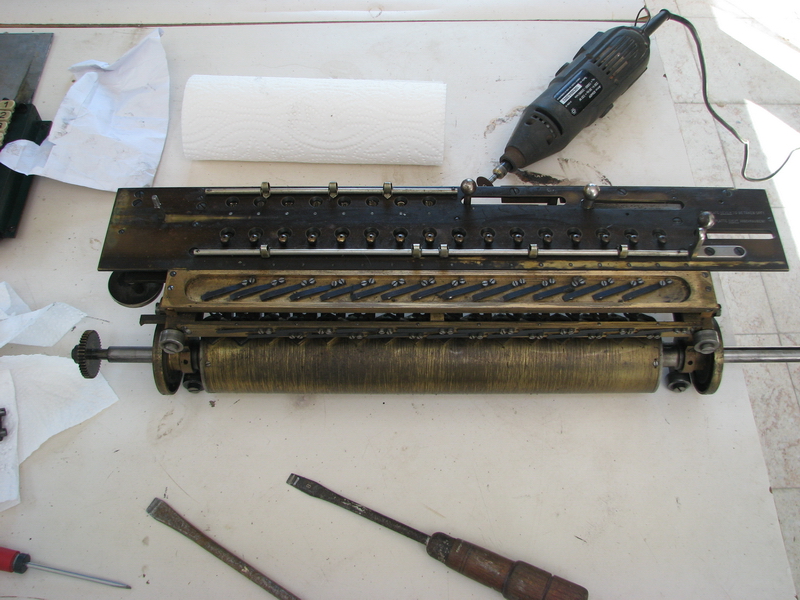
And here is the offending broken axle - the brass gear found loose in the machine has already been taken off the broken part, and is on the left of the picture:

The repair was effected quickly by drilling both ends, and inserting a pin with anaerobic metal bonding agent. It was rather important to get the orientation of the broken tip exactly right, as it is cross-drilled for a conical pin, and any rotation of this hole with respect to the rest of the axle would screw up the alignment of the gear.

Fixed!

Once this was done, and while the bonding agent was hardening, the machine was roughly cleaned in order to get all the dust and grease out. It then looked like this:



I proceeded to reassemble the axle into the machine, going by the position of the tooth on the large gear that I remembered. But we'll get back to this.
Axle in:

Connecting axle back:

And gear pinned in place:
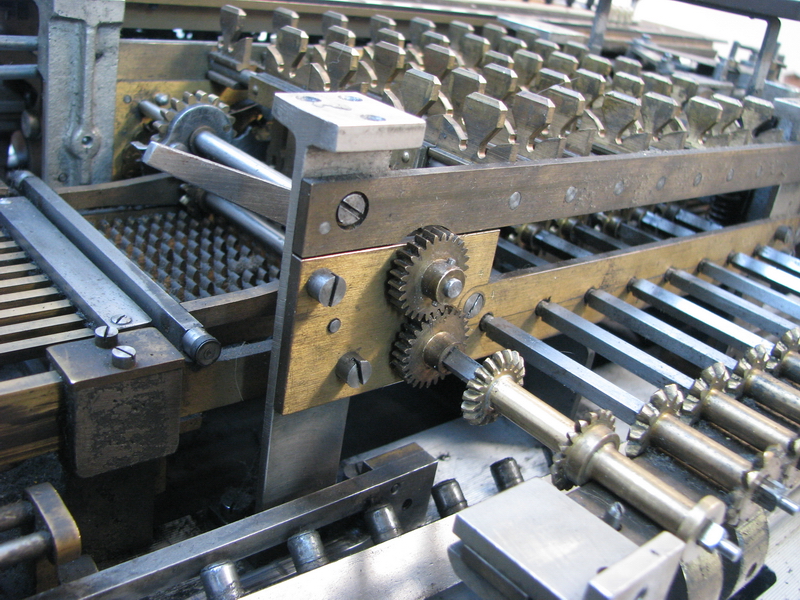
As repairs on complicated machinery tend to get out of hand quickly, I then found I could no longer reassemble the bottom end plate holding all the square axles in place. One of the axles had shifted downwards, I couldn't see where it was binding, so out came the second carriage. This gave me more opportunity for cleaning.
Note that the carriages are absolutely not identical - the construction of the machine requires the top carriage to be more or less a mirror image of the bottom carriage, except of course for the numeral wheels, which are then mounted upside down, and the drive for the tens' carry, which is on the "wrong" end in the top carriage, because it is not fed through to the other side of the machine as it is in the bottom carriage - this because of the carriage movement mechanism, which is located in the middle of this through-axle. The top carriage has no locating system, it is simply connected to the bottom carriage, and it has no counter register either. As detailed above, the numeral wheels at the top are much larger to make them easier to read, and there's space in the carriage anyway.
Here's the machine:

And here are the carriages:

Top carriage, without counter register - notice the strangely shaped levers for tens' carry.


And bottom carriage, with counter register.


It turned out that the offending square axle that prompted all this further disassembly had just come undone from its location spring, which is located at the top of the keyboard, beneath the uppermost brass slider for the gears. Once I figured that out, it was a two minute job to lift up the spring and slide the axle back to its correct position. As you can see everything is back in place here, and the brass strip at the bottom of the axles is correctly mounted back.



This is where the magic happens - the mechanical lookup table for multiplication results

I took the plates on the bottom off - why not, more cleaning!

Someone at the factory made some parts for this machine on a Monday morning, after a difficult weekend - everything in the machine is stamped with 44, 244, or 9244, which is the serial number of the machine.

The two steel slidebars at the top of the carriages though, are stamped with 9294. Oops.
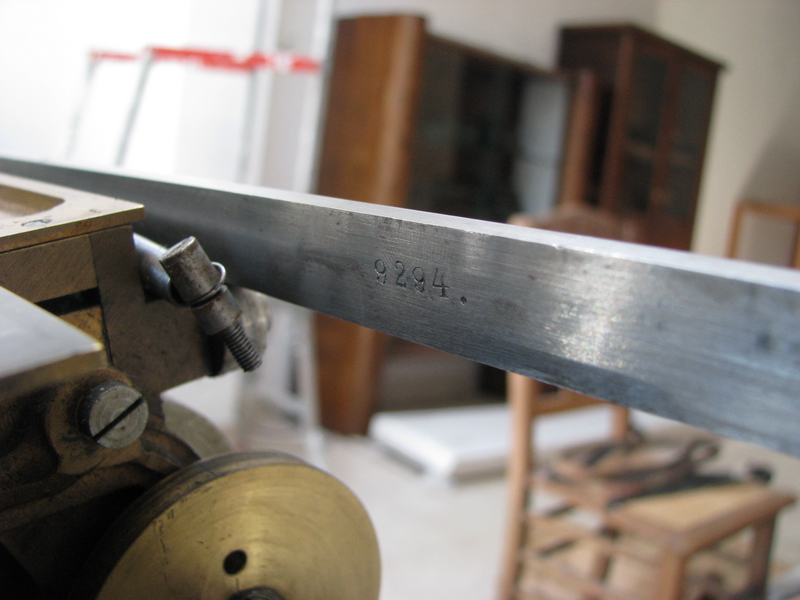
Carriages back in, and it is on to reassembly.



Left and right top plates back in place - now the machine can calculate (but setting numbers and having them stay set without keyboard is nigh on impossible). Trials went well at this point.
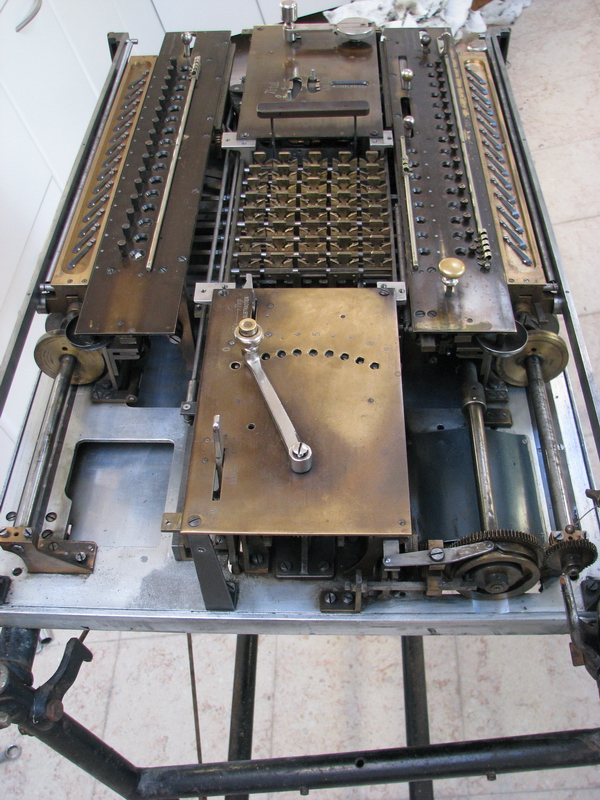


Cleaning the inside of the aluminium case plates- as you can see, they were a little dirty ...

Casing back in place.

And finally the top plates of the machine buttoned up again.



All that was left was this - the keyboard. I cleaned it up a little, and the family resemblance to MADAS is obvious - it is essentially the same keyboard, apart from the fact that it is upside down. Mounting a keyboard back onto a machine is always a bit of a stressy affair, as the way these things operate is by having five sliders, each connected to one gear. You can see them in the picture above - the five brass things sticking up in every keyboard column. Two keys share a slider, e.g. numbers 4 and 5. The slider has a fork at the bottom, which sits loosely over a gear. Since the axle is square, and the gear has a square hole down the middle, the gear can slide up and down, but if it rotates, the axle rotates with it. Pushing the "5" key will slide the slider and gear down, to engage with the rack that connects to the "5" row in the mechanical lookup table. Pushing the "4" key will slide the gear up, to engage with the "4" rack. In the mean time the four other gears in the column sit inbetween the racks and engage nothing at all during operation. But this means that for every column, all 5 sliders, which, when unconnected to the keyboard, are completely free to move over their axles, must all be in the perfect position for the keyboard to fit. In addition, their forks must all be engaged with their respective gears, because if they are not, the keyboard will fit just fine, but afterwards the machine will miscalculate or block. And the gears slip out of these forks very easily ...
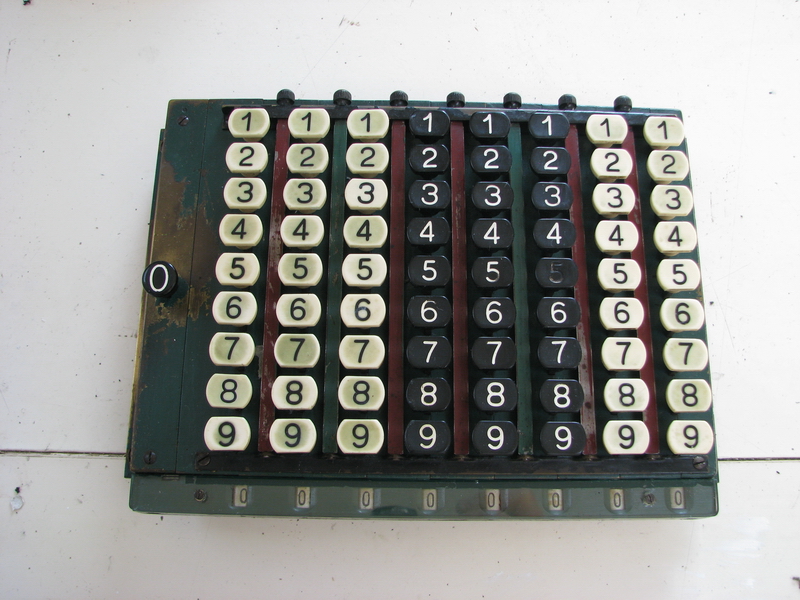
Mounted on the machine - ready for testing.


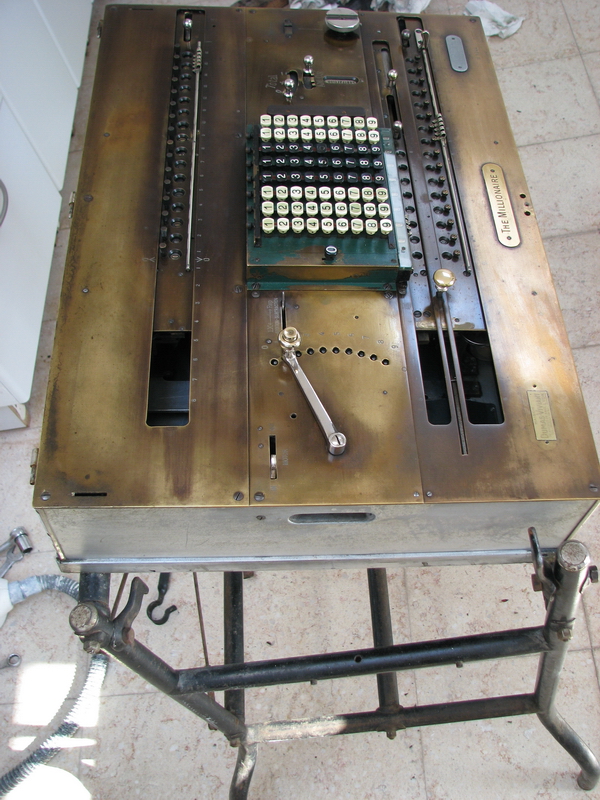
Now, when reassembling something as complicated as a Millionaire, one should not get one's hopes up - it's not because it's back together, that this is the end of restoration. There are bound to be things that are misaligned, not connected, or screwed up by someone who worked on the machine previously and gave up in disgust. But this is the time for finding out ... so, after testing thoroughly, three things went wrong.
So the keyboard came back off ...
...and 30 minutes later ...

The automatic clearing of the keyboard requires the tooth on the gear for the counter register to engage with a lever on the other lever to the top left. Obviously, this wasn't happening, because the gear was off by a tooth. (remember I wrote that I set it according to where it was by memory ? Well, my memory has a resolution of about two teeth ...)
Here's the issue:

...and fixed! (but it took a little longer than just typing it ...) Can you spot the difference ?

When the machine goes through a cycle in addition/subtraction mode, this gear still rocks forward and backward, hence operating this pin, which is connected to the bar you see coming out from under the left top plate - it pushes against a pin sticking out the underside of the keyboard, that is connected to the "0" key, and hence resets the keyboard.
The other problems were easier to fix. The operation of the pushbar to the right of the keyboard interfaces with the part under the multiplier selector. It should have the same effect as pushing the button on the multiplier lever down, but clearly it didn't. The reason was that the short end of steel bar connected to the sector on the left in the picture below, was quite severely bent downwards. On purpose, I suppose, I do not see how such a thing could happen accidentally. Someone got tired of the pushbar and wanted it inoperable? Anyway, it took about five disassemblies and assemblies of the left top plate to get the bend in the bar correct - i.e., exactly straight, but of course I didn't know that at the time ... anyway, fixed.

And then finally the keyboard locking device is this:

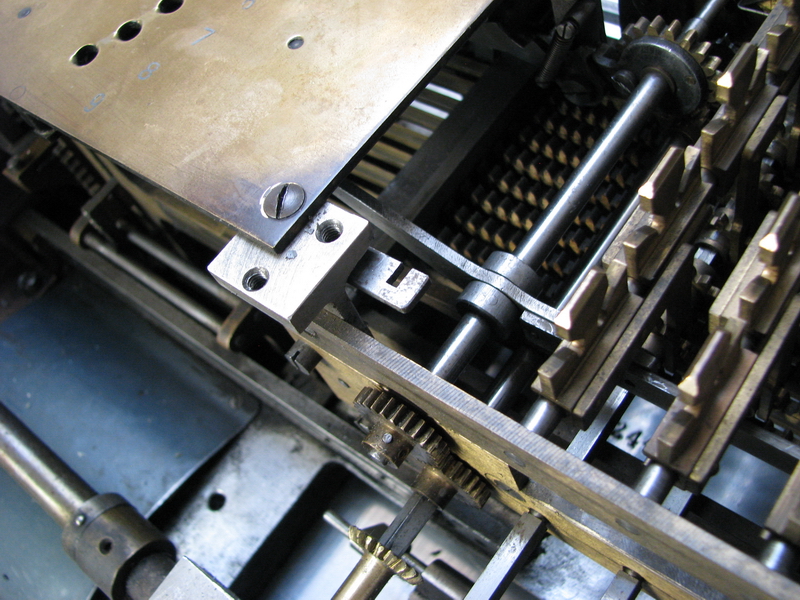
it's just a sliding bar that connects via this slot to a lever on the bottom of the keyboard. That was an easy one, but it gets easily forgotten because it is a pain in the neck to connect back up correctly, and needs to be shifted way out of the way to get the top plate back into the machine, and then it is easy to forget.
Here the carriage is back, all is looking good.
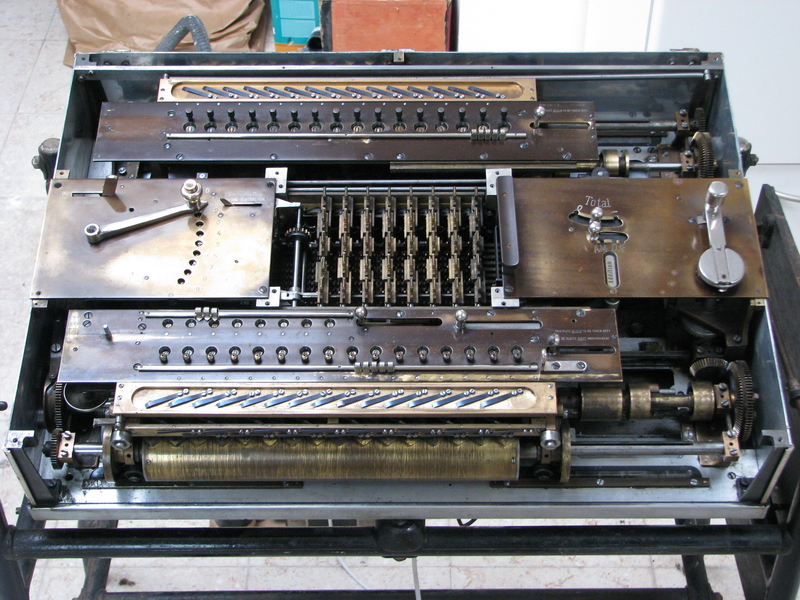
And finally, here's the picture of the reassembled machine. Also, the motor was cleaned and runs, the next step was to find a suitable drive band, because the ones that came with it are perished and are either way too tight, or so sloppy they slip and fall off.

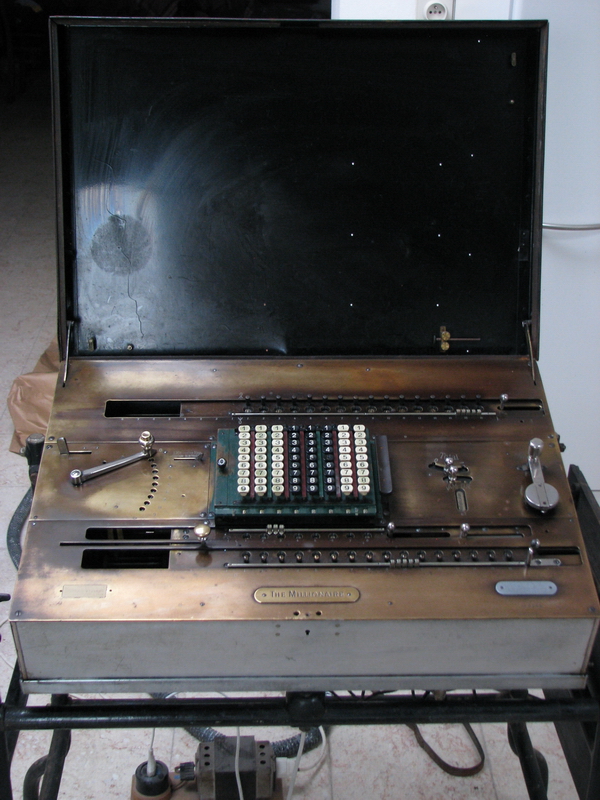
By increasing the tension on the sloppy driveband a little by means of a small pulley that is provided for this very reason, the belt would stay on the machine, and would allow calculation. Under motor power, the machine runs faster, and immediately another issue became clear - during multiplication, the counter register would now give a twist of half a number to the previous multiplier, right before moving the carriage to the left for the next operation. This would obviously not do, and I had the impression that it could be related to the orientation of the counter gear train. A square shaft has four sides and fourfold symmetry, but a gear with 26 teeth has only 2-fold symmetry - hence there are two different ways to orient the shaft, which are not identical - one of them will have a tooth of the multiplier conical gear with 18 teeth pointing straight up, and over the course of a rotation of 7 teeth in the 26-tooth gear, the gap between two teeth will now be pointing straight up. And of course now as well, the odds of getting it right had worked against me ... but to correct it, the front carriage had to come out - again! (I could add another 25 pictures here that are extremely similar to what's already above ...)
When this issue was fixed, I didn't pay attention when putting the carriage back, and accidentally rotated the tens' carry cylinder by a tooth or two. There are indicator marks on the gears, but I didn't notice until the location bar was back in place ... so out it had to come, again.
After fooling with the orientation of the tens carry cylinder and getting it right, I put the toothed rack on the bottom carriage back into engagement with the gear that connects it to the top carriage, but unfortunately off by one tooth - it's only a millimetre or two, but it is enough to make the top carriage miscalculate completely, because it is now misaligned with respect to the bottom carriage, which has the locator bar. So, it had to be disassembled yet again.
But I'm glad to say that this time, I finally got it right, and the machine came through all of my tests with flying colours, both in manual operation and electrically. Fingers crossed the loctite on the repaired shaft doesn't let go! Time to put the covers back on and enjoy some pictures and a video!

I've made a separate page where I demonstrate how the performance of the Millionaire stacks up against the TIM-Unitas, as well as a video where I calculate some statistics on a set of 9 numbers. Those last shenanigans take about 20 minutes, but rest assured, with a "regular" calculator with only a single accumulator register, it would take a lot longer! You can find the page with the videos here.
